Resource Dependency Theory: An Analysis of Non-Profit Organizations
VerifiedAdded on 2022/10/02
|10
|2595
|109
AI Summary
This article analyzes the impact of Resource Dependency Theory on non-profit organizations and their adaptations towards dependencies and compliances. It also includes an annotated bibliography of related research studies.
Contribute Materials
Your contribution can guide someone’s learning journey. Share your
documents today.
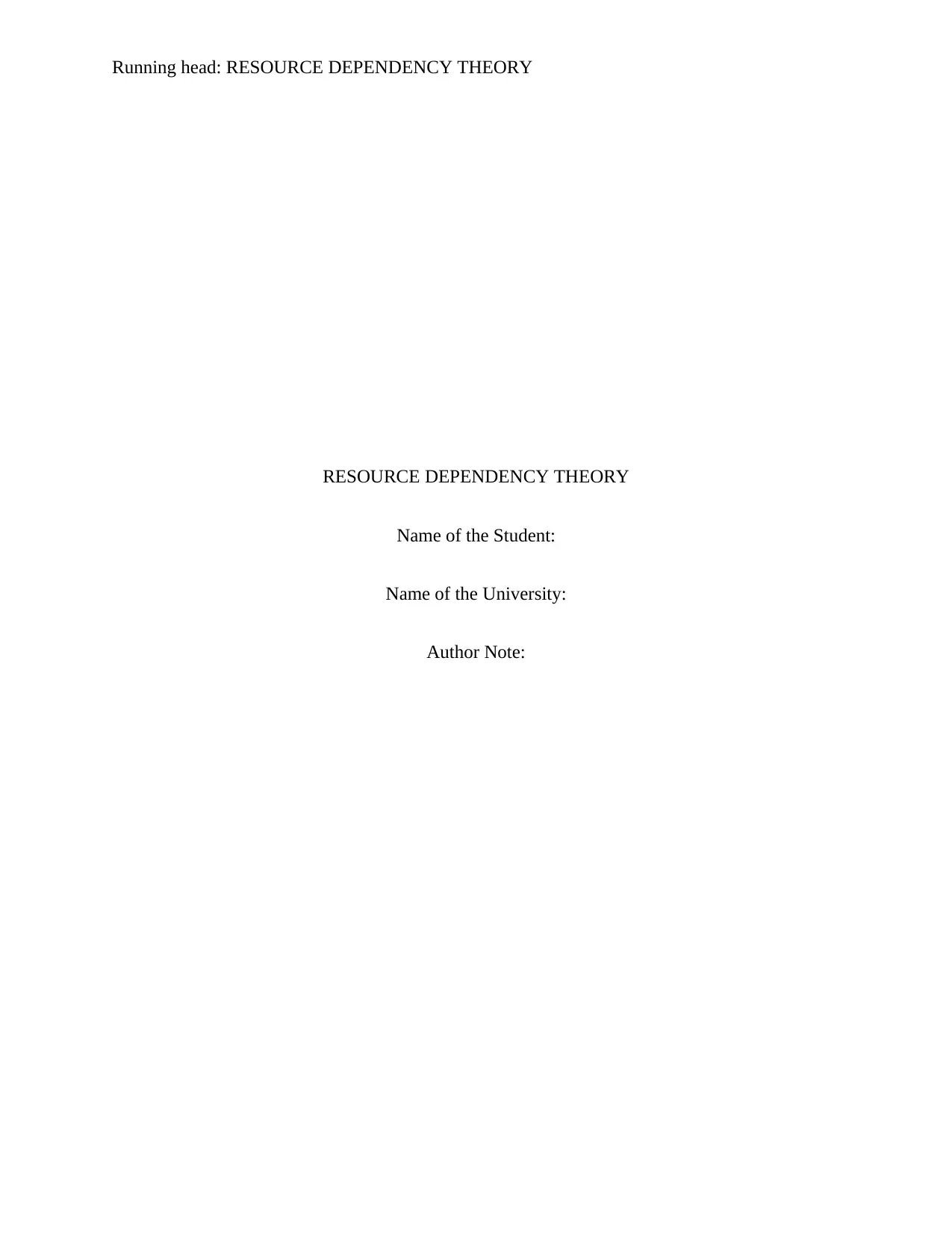
Running head: RESOURCE DEPENDENCY THEORY
RESOURCE DEPENDENCY THEORY
Name of the Student:
Name of the University:
Author Note:
RESOURCE DEPENDENCY THEORY
Name of the Student:
Name of the University:
Author Note:
Secure Best Marks with AI Grader
Need help grading? Try our AI Grader for instant feedback on your assignments.
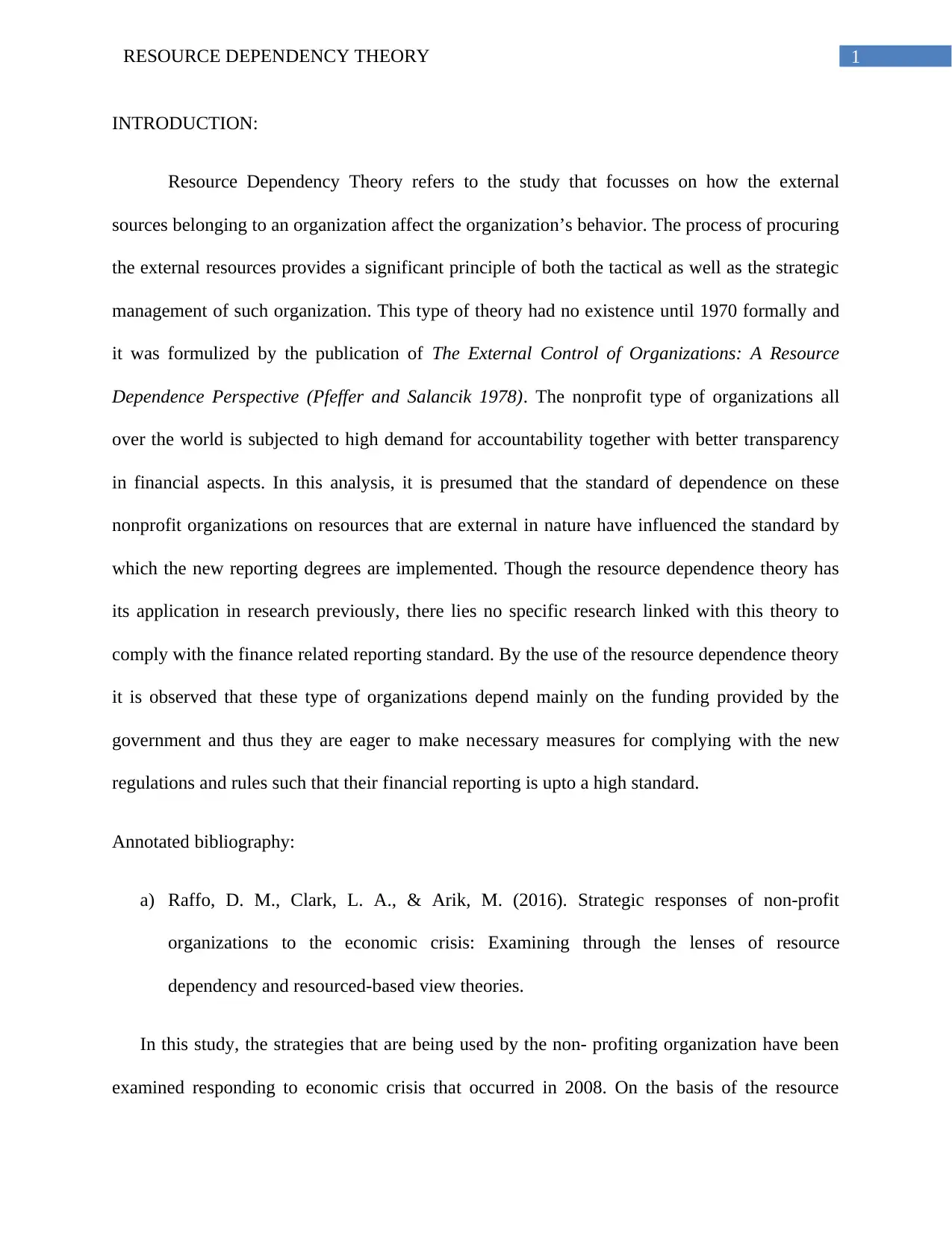
1RESOURCE DEPENDENCY THEORY
INTRODUCTION:
Resource Dependency Theory refers to the study that focusses on how the external
sources belonging to an organization affect the organization’s behavior. The process of procuring
the external resources provides a significant principle of both the tactical as well as the strategic
management of such organization. This type of theory had no existence until 1970 formally and
it was formulized by the publication of The External Control of Organizations: A Resource
Dependence Perspective (Pfeffer and Salancik 1978). The nonprofit type of organizations all
over the world is subjected to high demand for accountability together with better transparency
in financial aspects. In this analysis, it is presumed that the standard of dependence on these
nonprofit organizations on resources that are external in nature have influenced the standard by
which the new reporting degrees are implemented. Though the resource dependence theory has
its application in research previously, there lies no specific research linked with this theory to
comply with the finance related reporting standard. By the use of the resource dependence theory
it is observed that these type of organizations depend mainly on the funding provided by the
government and thus they are eager to make necessary measures for complying with the new
regulations and rules such that their financial reporting is upto a high standard.
Annotated bibliography:
a) Raffo, D. M., Clark, L. A., & Arik, M. (2016). Strategic responses of non-profit
organizations to the economic crisis: Examining through the lenses of resource
dependency and resourced-based view theories.
In this study, the strategies that are being used by the non- profiting organization have been
examined responding to economic crisis that occurred in 2008. On the basis of the resource
INTRODUCTION:
Resource Dependency Theory refers to the study that focusses on how the external
sources belonging to an organization affect the organization’s behavior. The process of procuring
the external resources provides a significant principle of both the tactical as well as the strategic
management of such organization. This type of theory had no existence until 1970 formally and
it was formulized by the publication of The External Control of Organizations: A Resource
Dependence Perspective (Pfeffer and Salancik 1978). The nonprofit type of organizations all
over the world is subjected to high demand for accountability together with better transparency
in financial aspects. In this analysis, it is presumed that the standard of dependence on these
nonprofit organizations on resources that are external in nature have influenced the standard by
which the new reporting degrees are implemented. Though the resource dependence theory has
its application in research previously, there lies no specific research linked with this theory to
comply with the finance related reporting standard. By the use of the resource dependence theory
it is observed that these type of organizations depend mainly on the funding provided by the
government and thus they are eager to make necessary measures for complying with the new
regulations and rules such that their financial reporting is upto a high standard.
Annotated bibliography:
a) Raffo, D. M., Clark, L. A., & Arik, M. (2016). Strategic responses of non-profit
organizations to the economic crisis: Examining through the lenses of resource
dependency and resourced-based view theories.
In this study, the strategies that are being used by the non- profiting organization have been
examined responding to economic crisis that occurred in 2008. On the basis of the resource
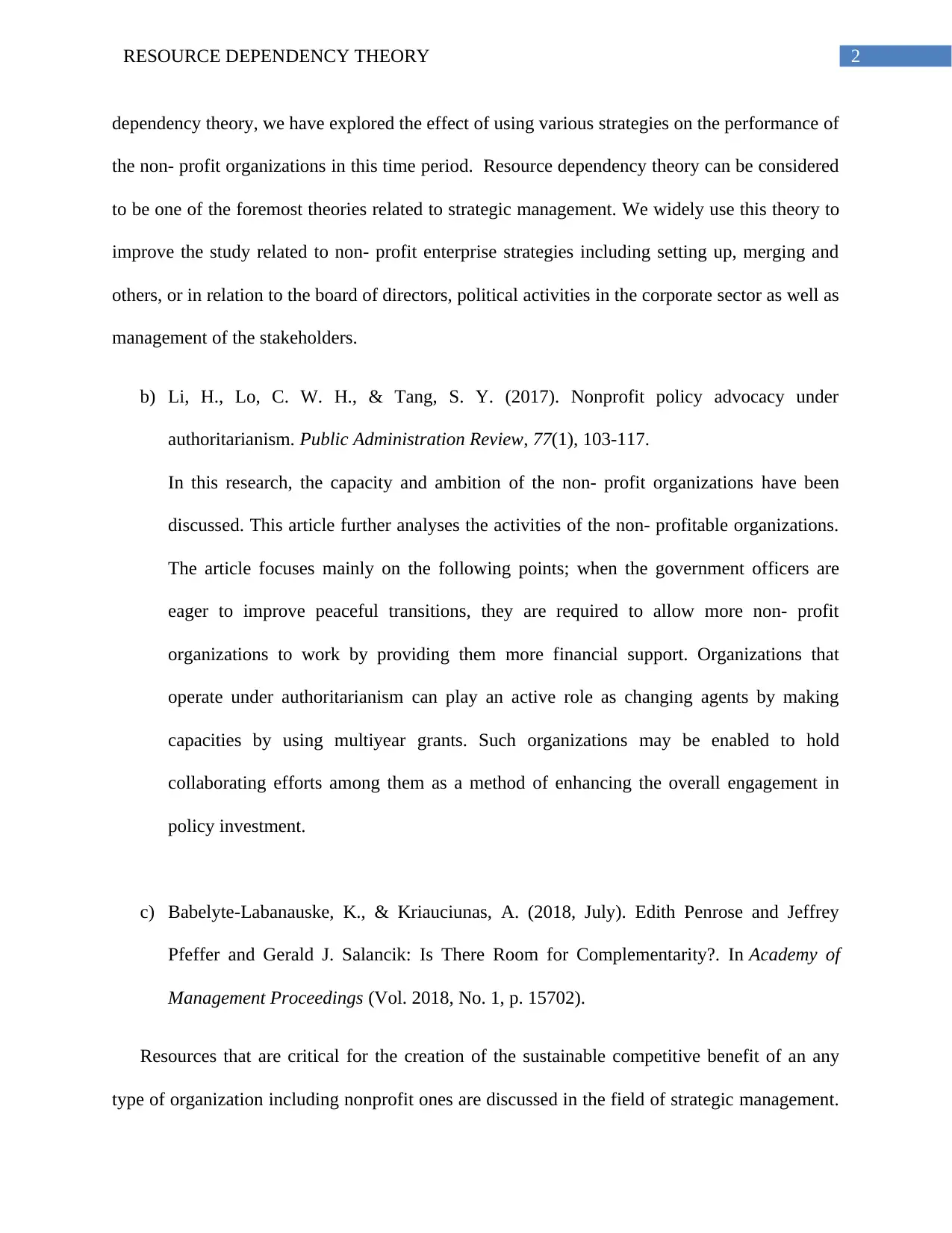
2RESOURCE DEPENDENCY THEORY
dependency theory, we have explored the effect of using various strategies on the performance of
the non- profit organizations in this time period. Resource dependency theory can be considered
to be one of the foremost theories related to strategic management. We widely use this theory to
improve the study related to non- profit enterprise strategies including setting up, merging and
others, or in relation to the board of directors, political activities in the corporate sector as well as
management of the stakeholders.
b) Li, H., Lo, C. W. H., & Tang, S. Y. (2017). Nonprofit policy advocacy under
authoritarianism. Public Administration Review, 77(1), 103-117.
In this research, the capacity and ambition of the non- profit organizations have been
discussed. This article further analyses the activities of the non- profitable organizations.
The article focuses mainly on the following points; when the government officers are
eager to improve peaceful transitions, they are required to allow more non- profit
organizations to work by providing them more financial support. Organizations that
operate under authoritarianism can play an active role as changing agents by making
capacities by using multiyear grants. Such organizations may be enabled to hold
collaborating efforts among them as a method of enhancing the overall engagement in
policy investment.
c) Babelyte-Labanauske, K., & Kriauciunas, A. (2018, July). Edith Penrose and Jeffrey
Pfeffer and Gerald J. Salancik: Is There Room for Complementarity?. In Academy of
Management Proceedings (Vol. 2018, No. 1, p. 15702).
Resources that are critical for the creation of the sustainable competitive benefit of an any
type of organization including nonprofit ones are discussed in the field of strategic management.
dependency theory, we have explored the effect of using various strategies on the performance of
the non- profit organizations in this time period. Resource dependency theory can be considered
to be one of the foremost theories related to strategic management. We widely use this theory to
improve the study related to non- profit enterprise strategies including setting up, merging and
others, or in relation to the board of directors, political activities in the corporate sector as well as
management of the stakeholders.
b) Li, H., Lo, C. W. H., & Tang, S. Y. (2017). Nonprofit policy advocacy under
authoritarianism. Public Administration Review, 77(1), 103-117.
In this research, the capacity and ambition of the non- profit organizations have been
discussed. This article further analyses the activities of the non- profitable organizations.
The article focuses mainly on the following points; when the government officers are
eager to improve peaceful transitions, they are required to allow more non- profit
organizations to work by providing them more financial support. Organizations that
operate under authoritarianism can play an active role as changing agents by making
capacities by using multiyear grants. Such organizations may be enabled to hold
collaborating efforts among them as a method of enhancing the overall engagement in
policy investment.
c) Babelyte-Labanauske, K., & Kriauciunas, A. (2018, July). Edith Penrose and Jeffrey
Pfeffer and Gerald J. Salancik: Is There Room for Complementarity?. In Academy of
Management Proceedings (Vol. 2018, No. 1, p. 15702).
Resources that are critical for the creation of the sustainable competitive benefit of an any
type of organization including nonprofit ones are discussed in the field of strategic management.
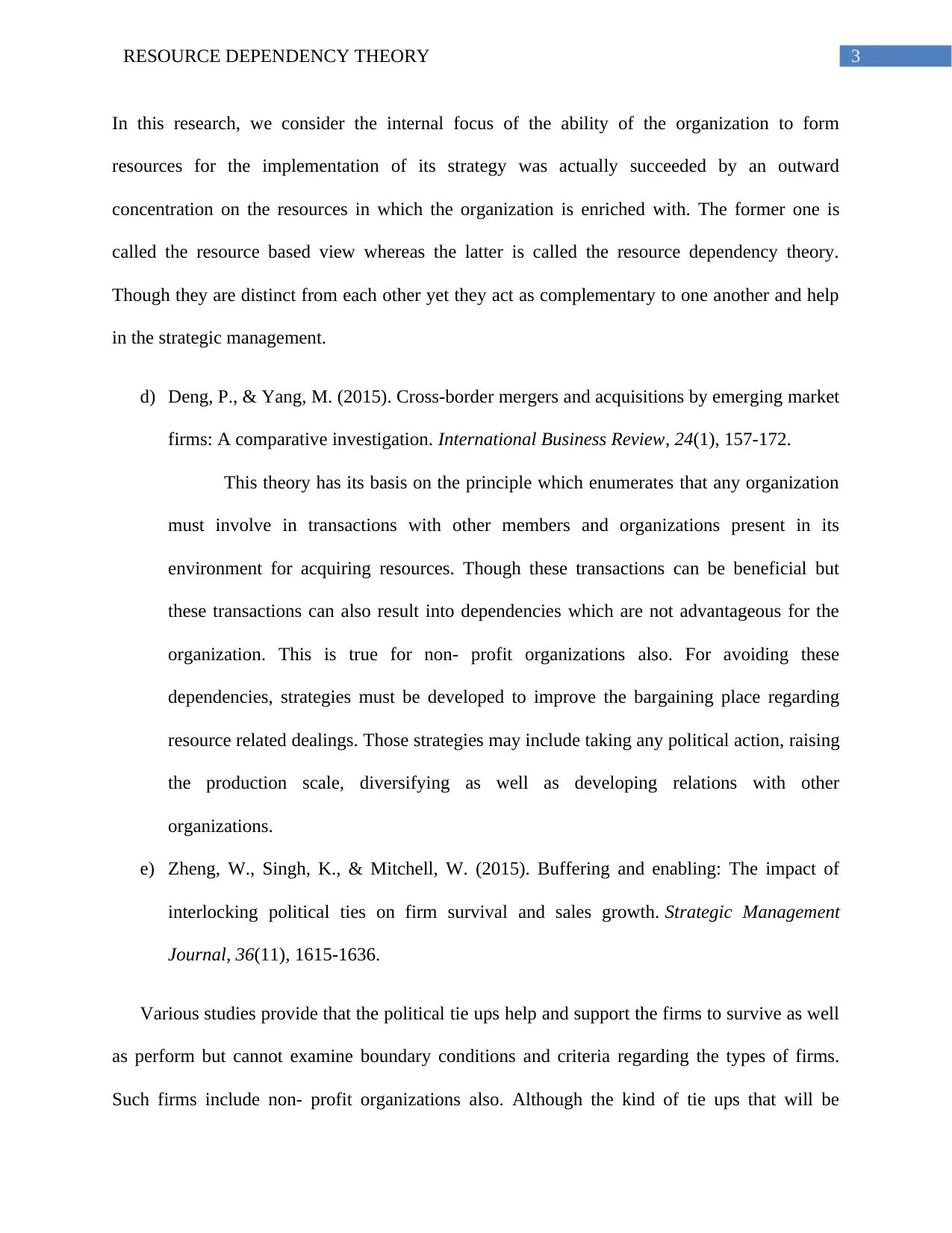
3RESOURCE DEPENDENCY THEORY
In this research, we consider the internal focus of the ability of the organization to form
resources for the implementation of its strategy was actually succeeded by an outward
concentration on the resources in which the organization is enriched with. The former one is
called the resource based view whereas the latter is called the resource dependency theory.
Though they are distinct from each other yet they act as complementary to one another and help
in the strategic management.
d) Deng, P., & Yang, M. (2015). Cross-border mergers and acquisitions by emerging market
firms: A comparative investigation. International Business Review, 24(1), 157-172.
This theory has its basis on the principle which enumerates that any organization
must involve in transactions with other members and organizations present in its
environment for acquiring resources. Though these transactions can be beneficial but
these transactions can also result into dependencies which are not advantageous for the
organization. This is true for non- profit organizations also. For avoiding these
dependencies, strategies must be developed to improve the bargaining place regarding
resource related dealings. Those strategies may include taking any political action, raising
the production scale, diversifying as well as developing relations with other
organizations.
e) Zheng, W., Singh, K., & Mitchell, W. (2015). Buffering and enabling: The impact of
interlocking political ties on firm survival and sales growth. Strategic Management
Journal, 36(11), 1615-1636.
Various studies provide that the political tie ups help and support the firms to survive as well
as perform but cannot examine boundary conditions and criteria regarding the types of firms.
Such firms include non- profit organizations also. Although the kind of tie ups that will be
In this research, we consider the internal focus of the ability of the organization to form
resources for the implementation of its strategy was actually succeeded by an outward
concentration on the resources in which the organization is enriched with. The former one is
called the resource based view whereas the latter is called the resource dependency theory.
Though they are distinct from each other yet they act as complementary to one another and help
in the strategic management.
d) Deng, P., & Yang, M. (2015). Cross-border mergers and acquisitions by emerging market
firms: A comparative investigation. International Business Review, 24(1), 157-172.
This theory has its basis on the principle which enumerates that any organization
must involve in transactions with other members and organizations present in its
environment for acquiring resources. Though these transactions can be beneficial but
these transactions can also result into dependencies which are not advantageous for the
organization. This is true for non- profit organizations also. For avoiding these
dependencies, strategies must be developed to improve the bargaining place regarding
resource related dealings. Those strategies may include taking any political action, raising
the production scale, diversifying as well as developing relations with other
organizations.
e) Zheng, W., Singh, K., & Mitchell, W. (2015). Buffering and enabling: The impact of
interlocking political ties on firm survival and sales growth. Strategic Management
Journal, 36(11), 1615-1636.
Various studies provide that the political tie ups help and support the firms to survive as well
as perform but cannot examine boundary conditions and criteria regarding the types of firms.
Such firms include non- profit organizations also. Although the kind of tie ups that will be
Secure Best Marks with AI Grader
Need help grading? Try our AI Grader for instant feedback on your assignments.
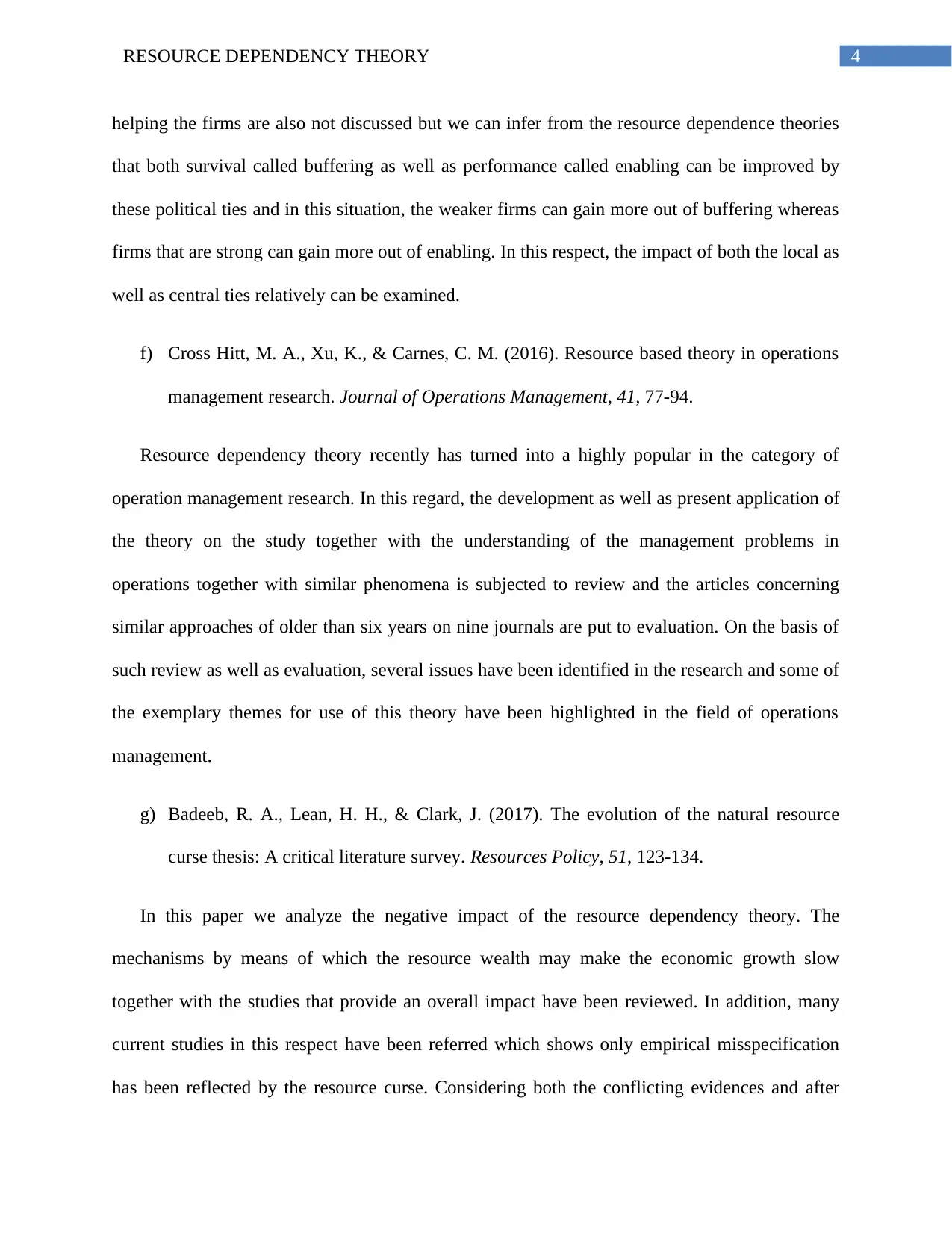
4RESOURCE DEPENDENCY THEORY
helping the firms are also not discussed but we can infer from the resource dependence theories
that both survival called buffering as well as performance called enabling can be improved by
these political ties and in this situation, the weaker firms can gain more out of buffering whereas
firms that are strong can gain more out of enabling. In this respect, the impact of both the local as
well as central ties relatively can be examined.
f) Cross Hitt, M. A., Xu, K., & Carnes, C. M. (2016). Resource based theory in operations
management research. Journal of Operations Management, 41, 77-94.
Resource dependency theory recently has turned into a highly popular in the category of
operation management research. In this regard, the development as well as present application of
the theory on the study together with the understanding of the management problems in
operations together with similar phenomena is subjected to review and the articles concerning
similar approaches of older than six years on nine journals are put to evaluation. On the basis of
such review as well as evaluation, several issues have been identified in the research and some of
the exemplary themes for use of this theory have been highlighted in the field of operations
management.
g) Badeeb, R. A., Lean, H. H., & Clark, J. (2017). The evolution of the natural resource
curse thesis: A critical literature survey. Resources Policy, 51, 123-134.
In this paper we analyze the negative impact of the resource dependency theory. The
mechanisms by means of which the resource wealth may make the economic growth slow
together with the studies that provide an overall impact have been reviewed. In addition, many
current studies in this respect have been referred which shows only empirical misspecification
has been reflected by the resource curse. Considering both the conflicting evidences and after
helping the firms are also not discussed but we can infer from the resource dependence theories
that both survival called buffering as well as performance called enabling can be improved by
these political ties and in this situation, the weaker firms can gain more out of buffering whereas
firms that are strong can gain more out of enabling. In this respect, the impact of both the local as
well as central ties relatively can be examined.
f) Cross Hitt, M. A., Xu, K., & Carnes, C. M. (2016). Resource based theory in operations
management research. Journal of Operations Management, 41, 77-94.
Resource dependency theory recently has turned into a highly popular in the category of
operation management research. In this regard, the development as well as present application of
the theory on the study together with the understanding of the management problems in
operations together with similar phenomena is subjected to review and the articles concerning
similar approaches of older than six years on nine journals are put to evaluation. On the basis of
such review as well as evaluation, several issues have been identified in the research and some of
the exemplary themes for use of this theory have been highlighted in the field of operations
management.
g) Badeeb, R. A., Lean, H. H., & Clark, J. (2017). The evolution of the natural resource
curse thesis: A critical literature survey. Resources Policy, 51, 123-134.
In this paper we analyze the negative impact of the resource dependency theory. The
mechanisms by means of which the resource wealth may make the economic growth slow
together with the studies that provide an overall impact have been reviewed. In addition, many
current studies in this respect have been referred which shows only empirical misspecification
has been reflected by the resource curse. Considering both the conflicting evidences and after
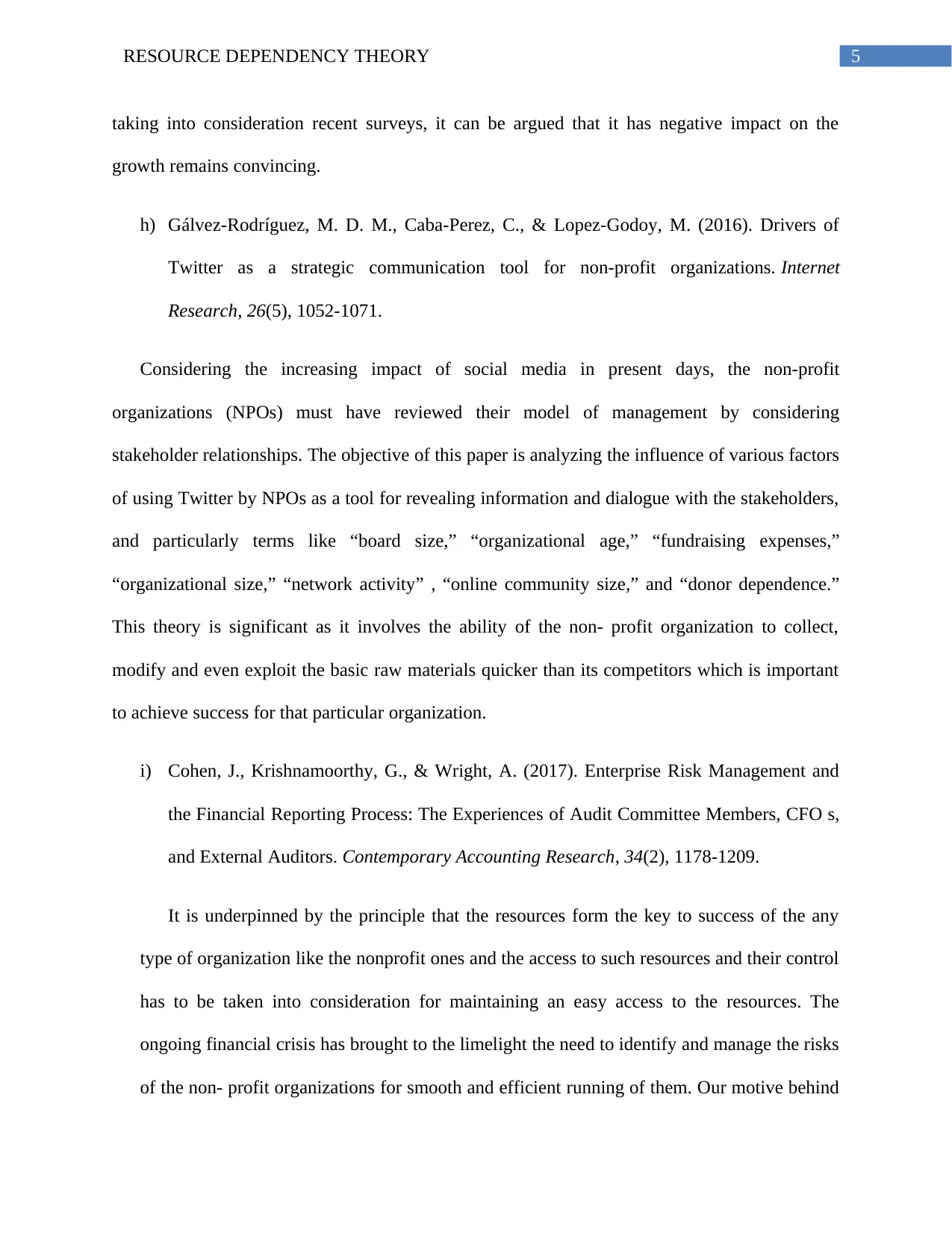
5RESOURCE DEPENDENCY THEORY
taking into consideration recent surveys, it can be argued that it has negative impact on the
growth remains convincing.
h) Gálvez-Rodríguez, M. D. M., Caba-Perez, C., & Lopez-Godoy, M. (2016). Drivers of
Twitter as a strategic communication tool for non-profit organizations. Internet
Research, 26(5), 1052-1071.
Considering the increasing impact of social media in present days, the non-profit
organizations (NPOs) must have reviewed their model of management by considering
stakeholder relationships. The objective of this paper is analyzing the influence of various factors
of using Twitter by NPOs as a tool for revealing information and dialogue with the stakeholders,
and particularly terms like “board size,” “organizational age,” “fundraising expenses,”
“organizational size,” “network activity” , “online community size,” and “donor dependence.”
This theory is significant as it involves the ability of the non- profit organization to collect,
modify and even exploit the basic raw materials quicker than its competitors which is important
to achieve success for that particular organization.
i) Cohen, J., Krishnamoorthy, G., & Wright, A. (2017). Enterprise Risk Management and
the Financial Reporting Process: The Experiences of Audit Committee Members, CFO s,
and External Auditors. Contemporary Accounting Research, 34(2), 1178-1209.
It is underpinned by the principle that the resources form the key to success of the any
type of organization like the nonprofit ones and the access to such resources and their control
has to be taken into consideration for maintaining an easy access to the resources. The
ongoing financial crisis has brought to the limelight the need to identify and manage the risks
of the non- profit organizations for smooth and efficient running of them. Our motive behind
taking into consideration recent surveys, it can be argued that it has negative impact on the
growth remains convincing.
h) Gálvez-Rodríguez, M. D. M., Caba-Perez, C., & Lopez-Godoy, M. (2016). Drivers of
Twitter as a strategic communication tool for non-profit organizations. Internet
Research, 26(5), 1052-1071.
Considering the increasing impact of social media in present days, the non-profit
organizations (NPOs) must have reviewed their model of management by considering
stakeholder relationships. The objective of this paper is analyzing the influence of various factors
of using Twitter by NPOs as a tool for revealing information and dialogue with the stakeholders,
and particularly terms like “board size,” “organizational age,” “fundraising expenses,”
“organizational size,” “network activity” , “online community size,” and “donor dependence.”
This theory is significant as it involves the ability of the non- profit organization to collect,
modify and even exploit the basic raw materials quicker than its competitors which is important
to achieve success for that particular organization.
i) Cohen, J., Krishnamoorthy, G., & Wright, A. (2017). Enterprise Risk Management and
the Financial Reporting Process: The Experiences of Audit Committee Members, CFO s,
and External Auditors. Contemporary Accounting Research, 34(2), 1178-1209.
It is underpinned by the principle that the resources form the key to success of the any
type of organization like the nonprofit ones and the access to such resources and their control
has to be taken into consideration for maintaining an easy access to the resources. The
ongoing financial crisis has brought to the limelight the need to identify and manage the risks
of the non- profit organizations for smooth and efficient running of them. Our motive behind
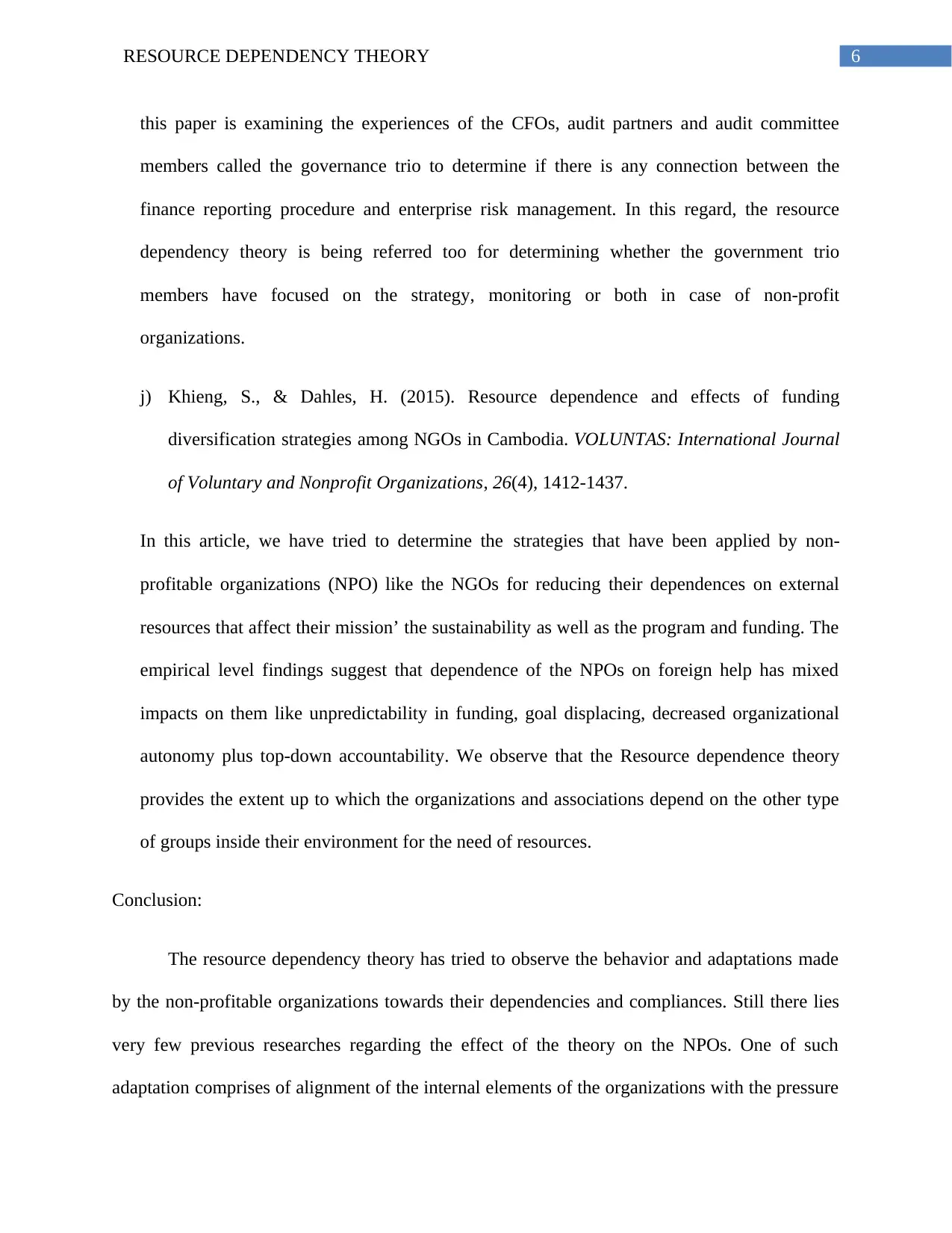
6RESOURCE DEPENDENCY THEORY
this paper is examining the experiences of the CFOs, audit partners and audit committee
members called the governance trio to determine if there is any connection between the
finance reporting procedure and enterprise risk management. In this regard, the resource
dependency theory is being referred too for determining whether the government trio
members have focused on the strategy, monitoring or both in case of non-profit
organizations.
j) Khieng, S., & Dahles, H. (2015). Resource dependence and effects of funding
diversification strategies among NGOs in Cambodia. VOLUNTAS: International Journal
of Voluntary and Nonprofit Organizations, 26(4), 1412-1437.
In this article, we have tried to determine the strategies that have been applied by non-
profitable organizations (NPO) like the NGOs for reducing their dependences on external
resources that affect their mission’ the sustainability as well as the program and funding. The
empirical level findings suggest that dependence of the NPOs on foreign help has mixed
impacts on them like unpredictability in funding, goal displacing, decreased organizational
autonomy plus top-down accountability. We observe that the Resource dependence theory
provides the extent up to which the organizations and associations depend on the other type
of groups inside their environment for the need of resources.
Conclusion:
The resource dependency theory has tried to observe the behavior and adaptations made
by the non-profitable organizations towards their dependencies and compliances. Still there lies
very few previous researches regarding the effect of the theory on the NPOs. One of such
adaptation comprises of alignment of the internal elements of the organizations with the pressure
this paper is examining the experiences of the CFOs, audit partners and audit committee
members called the governance trio to determine if there is any connection between the
finance reporting procedure and enterprise risk management. In this regard, the resource
dependency theory is being referred too for determining whether the government trio
members have focused on the strategy, monitoring or both in case of non-profit
organizations.
j) Khieng, S., & Dahles, H. (2015). Resource dependence and effects of funding
diversification strategies among NGOs in Cambodia. VOLUNTAS: International Journal
of Voluntary and Nonprofit Organizations, 26(4), 1412-1437.
In this article, we have tried to determine the strategies that have been applied by non-
profitable organizations (NPO) like the NGOs for reducing their dependences on external
resources that affect their mission’ the sustainability as well as the program and funding. The
empirical level findings suggest that dependence of the NPOs on foreign help has mixed
impacts on them like unpredictability in funding, goal displacing, decreased organizational
autonomy plus top-down accountability. We observe that the Resource dependence theory
provides the extent up to which the organizations and associations depend on the other type
of groups inside their environment for the need of resources.
Conclusion:
The resource dependency theory has tried to observe the behavior and adaptations made
by the non-profitable organizations towards their dependencies and compliances. Still there lies
very few previous researches regarding the effect of the theory on the NPOs. One of such
adaptation comprises of alignment of the internal elements of the organizations with the pressure
Paraphrase This Document
Need a fresh take? Get an instant paraphrase of this document with our AI Paraphraser
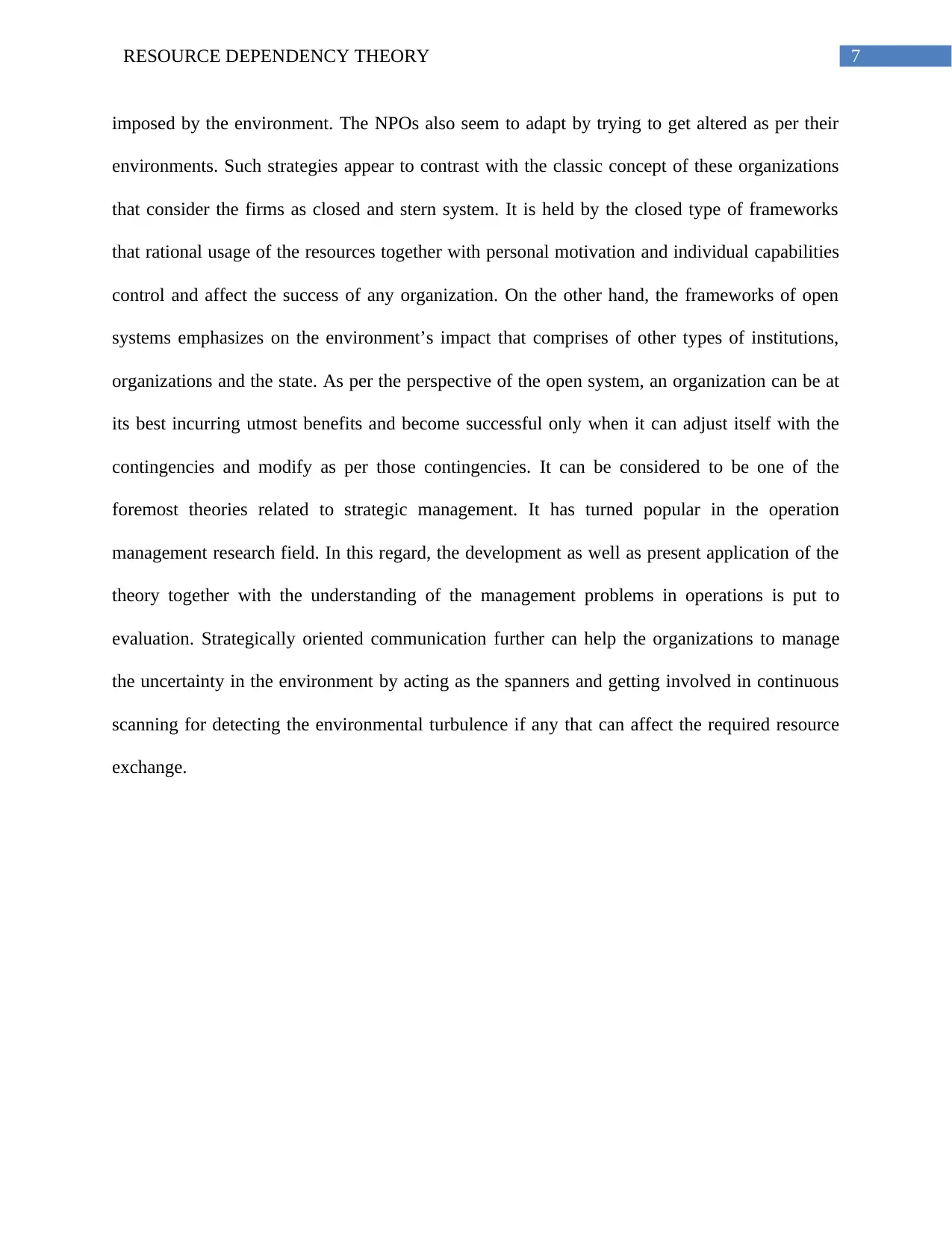
7RESOURCE DEPENDENCY THEORY
imposed by the environment. The NPOs also seem to adapt by trying to get altered as per their
environments. Such strategies appear to contrast with the classic concept of these organizations
that consider the firms as closed and stern system. It is held by the closed type of frameworks
that rational usage of the resources together with personal motivation and individual capabilities
control and affect the success of any organization. On the other hand, the frameworks of open
systems emphasizes on the environment’s impact that comprises of other types of institutions,
organizations and the state. As per the perspective of the open system, an organization can be at
its best incurring utmost benefits and become successful only when it can adjust itself with the
contingencies and modify as per those contingencies. It can be considered to be one of the
foremost theories related to strategic management. It has turned popular in the operation
management research field. In this regard, the development as well as present application of the
theory together with the understanding of the management problems in operations is put to
evaluation. Strategically oriented communication further can help the organizations to manage
the uncertainty in the environment by acting as the spanners and getting involved in continuous
scanning for detecting the environmental turbulence if any that can affect the required resource
exchange.
imposed by the environment. The NPOs also seem to adapt by trying to get altered as per their
environments. Such strategies appear to contrast with the classic concept of these organizations
that consider the firms as closed and stern system. It is held by the closed type of frameworks
that rational usage of the resources together with personal motivation and individual capabilities
control and affect the success of any organization. On the other hand, the frameworks of open
systems emphasizes on the environment’s impact that comprises of other types of institutions,
organizations and the state. As per the perspective of the open system, an organization can be at
its best incurring utmost benefits and become successful only when it can adjust itself with the
contingencies and modify as per those contingencies. It can be considered to be one of the
foremost theories related to strategic management. It has turned popular in the operation
management research field. In this regard, the development as well as present application of the
theory together with the understanding of the management problems in operations is put to
evaluation. Strategically oriented communication further can help the organizations to manage
the uncertainty in the environment by acting as the spanners and getting involved in continuous
scanning for detecting the environmental turbulence if any that can affect the required resource
exchange.
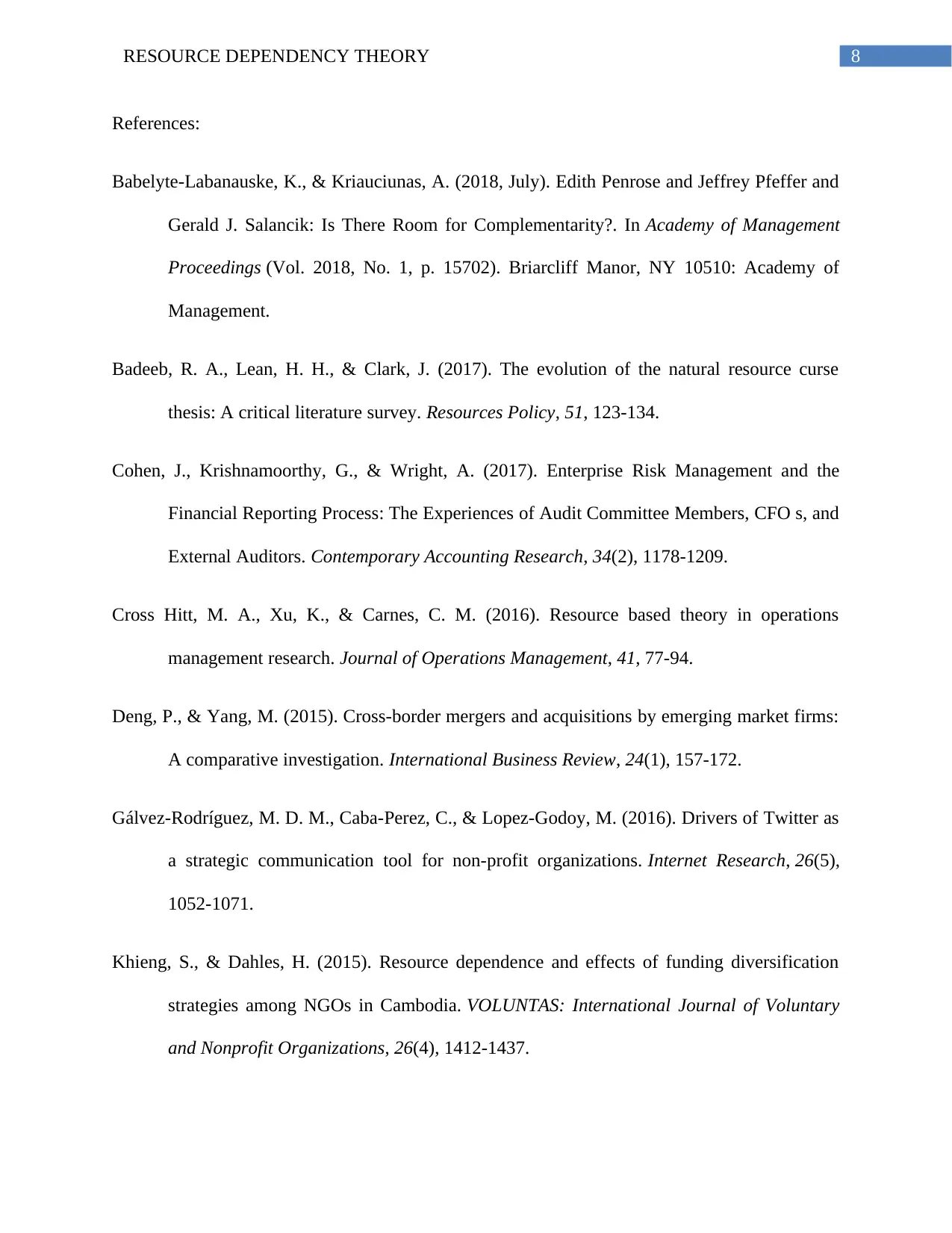
8RESOURCE DEPENDENCY THEORY
References:
Babelyte-Labanauske, K., & Kriauciunas, A. (2018, July). Edith Penrose and Jeffrey Pfeffer and
Gerald J. Salancik: Is There Room for Complementarity?. In Academy of Management
Proceedings (Vol. 2018, No. 1, p. 15702). Briarcliff Manor, NY 10510: Academy of
Management.
Badeeb, R. A., Lean, H. H., & Clark, J. (2017). The evolution of the natural resource curse
thesis: A critical literature survey. Resources Policy, 51, 123-134.
Cohen, J., Krishnamoorthy, G., & Wright, A. (2017). Enterprise Risk Management and the
Financial Reporting Process: The Experiences of Audit Committee Members, CFO s, and
External Auditors. Contemporary Accounting Research, 34(2), 1178-1209.
Cross Hitt, M. A., Xu, K., & Carnes, C. M. (2016). Resource based theory in operations
management research. Journal of Operations Management, 41, 77-94.
Deng, P., & Yang, M. (2015). Cross-border mergers and acquisitions by emerging market firms:
A comparative investigation. International Business Review, 24(1), 157-172.
Gálvez-Rodríguez, M. D. M., Caba-Perez, C., & Lopez-Godoy, M. (2016). Drivers of Twitter as
a strategic communication tool for non-profit organizations. Internet Research, 26(5),
1052-1071.
Khieng, S., & Dahles, H. (2015). Resource dependence and effects of funding diversification
strategies among NGOs in Cambodia. VOLUNTAS: International Journal of Voluntary
and Nonprofit Organizations, 26(4), 1412-1437.
References:
Babelyte-Labanauske, K., & Kriauciunas, A. (2018, July). Edith Penrose and Jeffrey Pfeffer and
Gerald J. Salancik: Is There Room for Complementarity?. In Academy of Management
Proceedings (Vol. 2018, No. 1, p. 15702). Briarcliff Manor, NY 10510: Academy of
Management.
Badeeb, R. A., Lean, H. H., & Clark, J. (2017). The evolution of the natural resource curse
thesis: A critical literature survey. Resources Policy, 51, 123-134.
Cohen, J., Krishnamoorthy, G., & Wright, A. (2017). Enterprise Risk Management and the
Financial Reporting Process: The Experiences of Audit Committee Members, CFO s, and
External Auditors. Contemporary Accounting Research, 34(2), 1178-1209.
Cross Hitt, M. A., Xu, K., & Carnes, C. M. (2016). Resource based theory in operations
management research. Journal of Operations Management, 41, 77-94.
Deng, P., & Yang, M. (2015). Cross-border mergers and acquisitions by emerging market firms:
A comparative investigation. International Business Review, 24(1), 157-172.
Gálvez-Rodríguez, M. D. M., Caba-Perez, C., & Lopez-Godoy, M. (2016). Drivers of Twitter as
a strategic communication tool for non-profit organizations. Internet Research, 26(5),
1052-1071.
Khieng, S., & Dahles, H. (2015). Resource dependence and effects of funding diversification
strategies among NGOs in Cambodia. VOLUNTAS: International Journal of Voluntary
and Nonprofit Organizations, 26(4), 1412-1437.
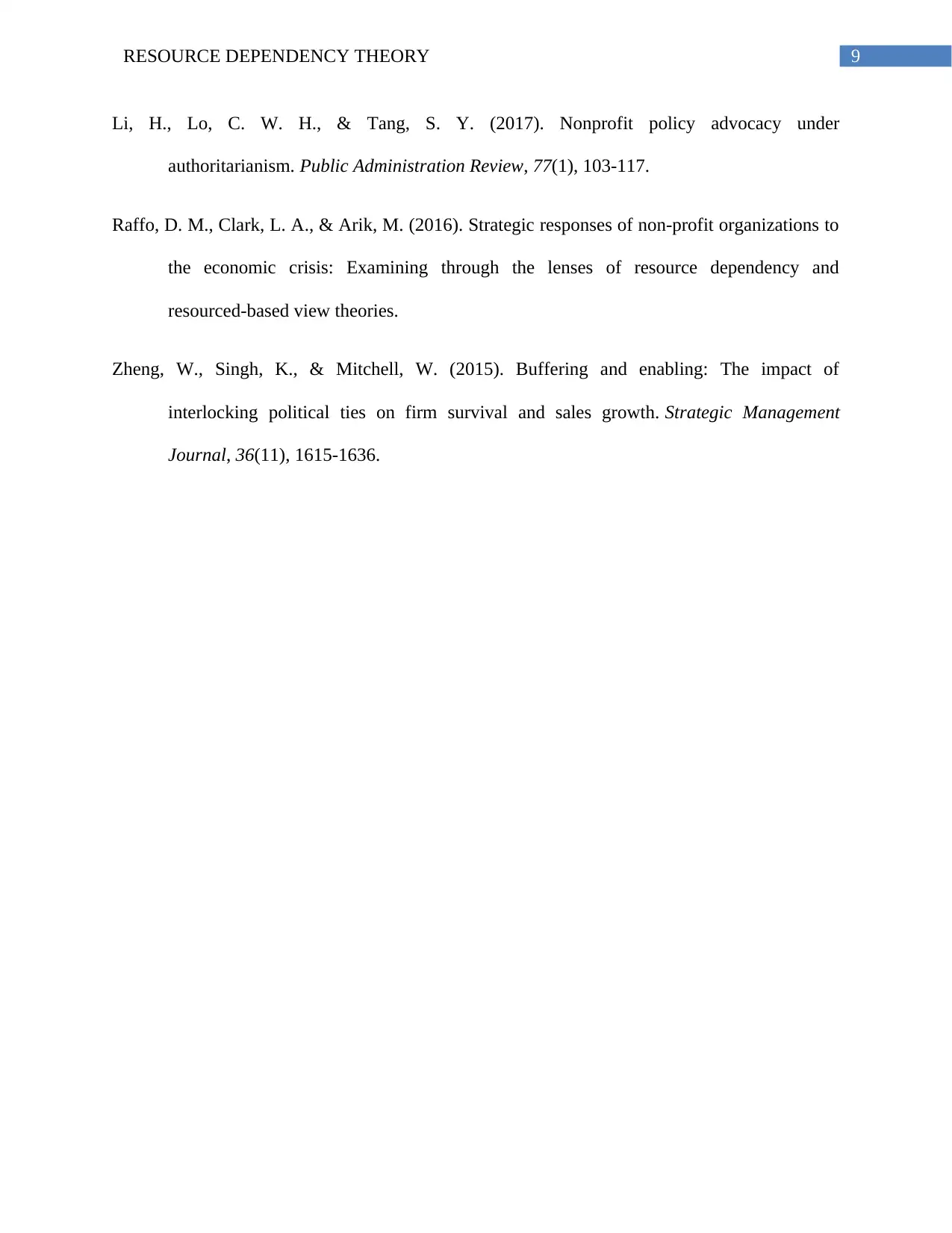
9RESOURCE DEPENDENCY THEORY
Li, H., Lo, C. W. H., & Tang, S. Y. (2017). Nonprofit policy advocacy under
authoritarianism. Public Administration Review, 77(1), 103-117.
Raffo, D. M., Clark, L. A., & Arik, M. (2016). Strategic responses of non-profit organizations to
the economic crisis: Examining through the lenses of resource dependency and
resourced-based view theories.
Zheng, W., Singh, K., & Mitchell, W. (2015). Buffering and enabling: The impact of
interlocking political ties on firm survival and sales growth. Strategic Management
Journal, 36(11), 1615-1636.
Li, H., Lo, C. W. H., & Tang, S. Y. (2017). Nonprofit policy advocacy under
authoritarianism. Public Administration Review, 77(1), 103-117.
Raffo, D. M., Clark, L. A., & Arik, M. (2016). Strategic responses of non-profit organizations to
the economic crisis: Examining through the lenses of resource dependency and
resourced-based view theories.
Zheng, W., Singh, K., & Mitchell, W. (2015). Buffering and enabling: The impact of
interlocking political ties on firm survival and sales growth. Strategic Management
Journal, 36(11), 1615-1636.
1 out of 10
Related Documents
Your All-in-One AI-Powered Toolkit for Academic Success.
+13062052269
info@desklib.com
Available 24*7 on WhatsApp / Email
![[object Object]](/_next/static/media/star-bottom.7253800d.svg)
Unlock your academic potential
© 2024 | Zucol Services PVT LTD | All rights reserved.





